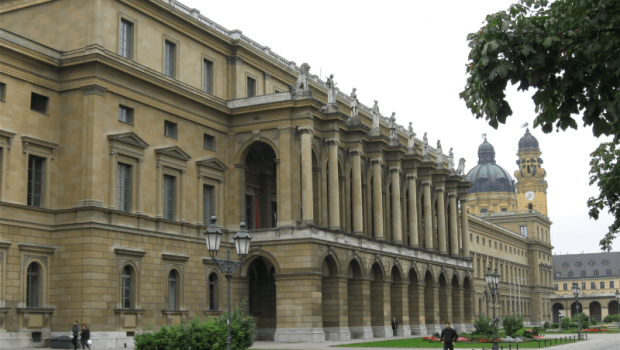
Residenz München – The royal palace
The Münchner Residenz (Munich Residenz), the royal palace of the erstwhile Bavarian monarchs of the House of Wittelsbach in Germany. The largest city palace in Germany, it also was the seat of power for the government and as a residence of the Dukes of Bavaria, as well as the electors and kings from 1508 to 1918. Today, the Residenz is open to visitors who are left intrigued by its architecture, decor, and royal collections. The Residenz in divided into three parts:
- Königsbau.
- Alte Residenz(Old Residenz).
- Festsaalbau(towards the Hofgarten). It contains within it the Cuvilliés Theatre ever since the reconstruction of the Residenz post-World War II, and also houses the venue for the Bavarian Radio Symphony Orchestra- Herkulessaal (Hercules Hall).
Location:
The Münchner Residenz resides within the centre of the city of Munich. The address of the Residenz is as follows-
Residenzstraße 1, 80333 München, Germany.
History:
The construction of the Residenz began in 1385 in the Neuveste, (New Citadel). It was soon transformed into a splendid palace by the rulers over the centuries.
William IV (1508–1550), ordered for the expansion of the Neuveste as well as the Rundstubenbau. This led to the setting up of the first Court Garden, with the Munich Residence flourishing as a representative palace.
Wilhelm Egkl under the reign of Albert V (1550–1579), built an art chamber in the earlier structure of the ducal stables, right next to one of the banqueting halls of the Neuveste (St. George Hall). Various collections in Munich are believed to originate from there. With the lack of space for containing an immense collection of sculptures, the Antiquarium was built outside the castle between 1568 and 1571.
Later, the Witwenstock (Widow Wing) was built under the order of William V (1579–1597) for the dowager Duchess Anna. This was followed by construction of four wings of the Grottenhof by Friedrich Sustris, in 1581-1586. The construction of the Black Hall was initiated in 1590. Under Sustris, the Erbprinzentrakt (Prince Wing), north of the Witwenstock, was added.
Maximilian I (1597–1651) authorized the Maximilianische Residenz (Maximilian Residenz), as well as rebuilt and connected the existing buildings. In 1612, he demolished major chunks of the Neuveste and Silver Tower. Meanwhile, between 1611 and 1619, the Kaiserhof (Emperor’s Courtyard), was built within the complex.
Maximilian’s initial successors upgraded and added smaller extensions such as the Grüne Galerie and the Residenz Theatre.
A major part of the Residenz was destroyed during the World War II, and from 1945 it was gradually reconstructed. Followed by the gradual recovery post World War II, the museums of the Bavarian Palace Department––the Residence Museum, the Cuvilliés Theatre, the Treasury, along with other cultural institutions––the Residenz stands as one of the largest museums’ in Bavaria today.
It was in 1920 that the Münchner Residenz was made accessible to the public in the form of a museum. Now, it ranks among the most important palace museums in the whole of Europe.
Tourists and visitors now have a window into developments of the princely through various time periods, such as Humanism, Enlightenment, and then to the constitutional monarchy. The museum authorities have made sure to keep intact the décor and the collections in order.
Some of the major parts of the Residenz are:
- Königsbau: Between 1825 and 1835 the Königsbau (King’s building) was constructed in the similar style of theFlorentine Palazzo Pitti. The building is 30 meters high. There are numerous suites of rooms, one of them being the State Apartment of Ludwig I, which is situated on the first floor, as well as the Nibelungen Halls on the ground floor. The Treasury is situated on the ground floor of the Königsbau. On the second floor are the Festgemächer, intended for minor court festivities. The rooms are still preserved, in a overly simplified form and are now home to the
- Festsaalbau: The Festsaalbau was added between 1832 and 1842 under King Ludwig I. The Large Throne Room and the Royal Reception Halls were located here. The Large Throne Room was replaced by the concert venue for the Bavarian Radio Symphony Orchestra- the Herkulessaal (Hercules Hall). Today, the Festsaalbau contains the BASH (Bavarian Academy of Sciences and Humanities), along with the Cuvilliés Theatre (Old Residenz Theatre) within it.
Within Residenz München – The following is the list of sites one will come across within the Residenz
- Ancestral Gallery and
Porcelain Cabinet - Antiquarium
- Court Chapel
- Rich Rooms
- Collections
- Papal Rooms and Golden Hall
- Imperial Staircase/
Imperial Hall/
Four White Horses Hall - Electoral Rooms
- Royal Palace
- Nibelungen Halls
- Rich Chapel
- Stone Rooms
- Conservatories (exhibition)
- Court Garden and
Charlotte Rooms - Treves Rooms
- Ancestral Gallery and Porcelain Cabinet: Joseph Effner was commissioned as the court architect of Karl Albrecht who became the Elector in 1726. Effner was asked to design the ancestral gallery. François Cuvilliés, the young architect, was involved in designing the decoration of this magnificent room as well; Wenzeslaus Miroffsky created the gilt carving on the walls and the stucco-work was done by Johann Baptist Zimmermann of Wessobrunn. Let into the carved gilt paneling of the gallery, are over a 100 portraits of members of the Wittelsbach family. The Ancestral Gallery, created under Karl Albrecht was a splendid monument, in order to draw attention to the dynasty. His claim to the Imperial Throne was a result of this work, which was successfully advanced in 1742.
- Antiquarium: Believed to be the oldest room in the Munich Residence, it stands as the largest Renaissance Hall, North of the Alps, with a length of66 metres. It was built by Duke Albrecht V, from 1568 to 1571 and name “Antiquarium” in order to complete his series of antique sculptures. The Antiquarium was transformed by Albrecht V’s successors, Duke Wilhelm V and his son Maximilian I into a hall for festivities and banquets, from 1581 to 1600. Allegories of fame and the virtues are portrayed through 16 paintings in the crown of the vault show, all from Peter Candid’s workshop. The view of the then Duchy of Bavaria has been revealed through a 102 views of towns, markets and palaces in the lunettes and the window. Many of Duke Albrecht V’s collection displayed on the longitudinal walls have however expanded in the 17th and18th centuries.
- Court Chapel: The Court Chapel was built in honour and dedication to the Virgin of the Immaculate Conception. It is assumed to be Maximilian’s choice, as he had already adopted the Virgin Mary as the patron saint of the Wittelsbach dynasty and of Bavaria. Hans Werl’s (1600) large central painting of the high altar displays the Virgin enthroned in glory beneath the Trinity. The two important masters, namely, Franz Zimmermann, South German Rococo, and Johann Baptist, created the two side altars next to the choir in themid-18th century.
- Reiche Zimmer (Rich Rooms): Acquiring their name in the 19th century, the Rich Rooms, stand as the highpoint of the court Rococo style in the area where mostly German speaking people inhabited. Karl Albrecht substantiated his claim to the imperial throne with these very state apartments. The floor plans as well as the decorations of the rooms were done by Cuvilliés, from the wall paneling, stucco-work and some of the furniture.The foreign envoys were officially received at the Audience Room.
With its amazing setting, The Green Gallery was the place for splendid festivities, where selected members of court were regularly invited by the Elector. The room was also used as a picture and mirror gallery.The Conference Chamber was also one of the important rooms, which was accessible only by the highest rank and members of the elector’s immediate family.The last of the Rich Rooms is the Miniatures Cabinet. This tiny room stands as an exclusive place of retreat within the apartment. Thousands of tourists visit the place every week, making it one of the most popular tourist hotposts in the region.
When to Visit:
The Münchner Residenz on all days, except:
1 January Shrove; Tuesday; 24 December; 25 December; 31 December
- Residence Museum – April – 16 October: 9 am-6 pm; 17 October – March: 10 am-5 pm
Treasury – April – 16 October: 9 am-6 pm; 17 October – March: 10 am – 5 pm - Cuvilliés Theatre
– April – 31 July, Mondays to Saturdays: 2 pm – 6 pm
On Sundays and public holidays: 9 am – 6 pm;
– August – 12 September, daily 9 am – 6 pm;
– 13 September – 16 October Mondays to Saturdays: 2 pm – 6 pm
On Sundays and public holidays: 9 am – 6 pm
– 17 October – March, Mondays to Saturdays: 2 pm – 5 pm
On Sundays and public holidays: 10 am – 5 pm - Bronze Halls: Open until 12 September 2016: daily 10 am – 5 pm
- Fountain machinery of the Court Garden: It can be toured every day. April to October daily from 10am to 2pm, it is in operational from.
There are no regular guided tours through the Residence. Although, free audio guide tours are available for languages such as Russian, French German, English, , Italian, and Spanish.
Places Nearby:
- Ammersee
- Benediktbeuren
- Oberammergau
- The Berchtesgaden National Park
- Bad Tolz
- Starnbergersee
- Augsburg
- Füssen
With so many amazing places to see and explore, Residenz Munchen and the nearby places offer a perfect place to spend some quality time away from the routine life schedule. So go ahead and plan a visit to this amazing place with your family and friends and make the most of your visit to Germany. You won’t regret it, we promise!
